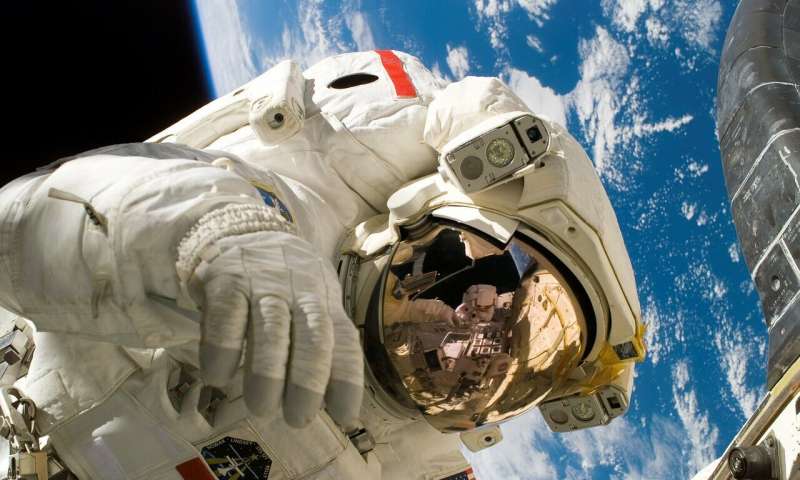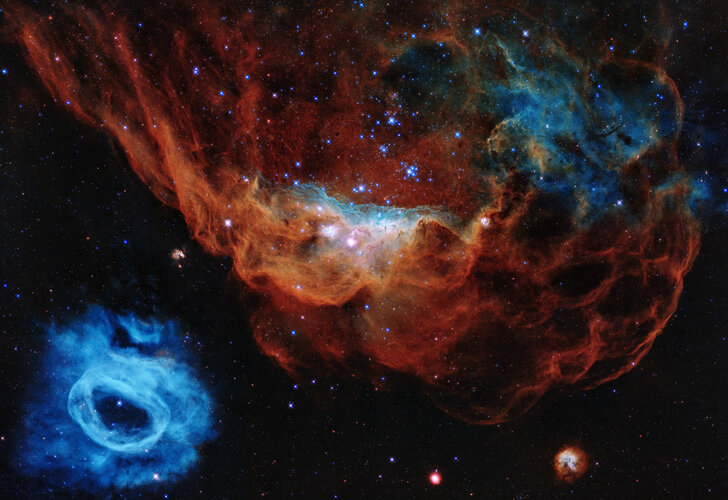
Copernical Team
Earthlings and astronauts chat away, via ham radio

The International Space Station cost more than $100 billion. A ham radio set can be had for a few hundred bucks.
Perhaps that explains, in part, the appeal of having one of humankind's greatest scientific inventions communicate with Earth via technology that's more than 100 years old. But perhaps there's a simpler explanation for why astronauts and ham radio operators have been talking, and talking, for years.
NASA astronaut Doug Wheelock was just a few weeks into his six-month mission at the space station when feelings of isolation began to set in.
Wheelock would be separated from loved ones, save for communication via an internet phone, email or social media. At times, the stress and tension of serving as the station's commander could be intense.
One night, as he looked out a window at the Earth below, he remembered the space station's ham radio. He figured he'd turn it on—see if anyone was listening.
"Any station, any station, this is the International Space Station," Wheelock said.
A flood of voices jumbled out of the airwaves.
Astronauts aboard the space station often speak to students via ham radio, which can also be used in emergencies, but those are scheduled appearances.
A-68A iceberg thinning at 2.5 cm per day

Latest images reveal that the A-68A iceberg has shattered into multiple pieces, with two large fragments of ice breaking off from the main berg and floating away in the open ocean. Scientists using satellite data have not only been monitoring the iceberg’s journey across the South Atlantic Ocean, but have been studying the iceberg’s ever-changing shape.
Year in images 2020

Our year through the lens: a selection of our favourite images for 2020
Image: Space bauble produced by the Multiscale Boiling experiment

Deck the halls with space-based bubbles!
Here is a festive bauble you will not see on Earth: a bubble produced by the Multiscale Boiling experiment, known affectionately as Rubi.
In this image, electrostatic forces are pulling the bubble upwards and making it spherical, producing not only a cool image but also cool insights into the boiling process.
Understanding how boiling behaves in weightlessness is imperative because gravity plays an important role. Without gravity, boiling takes place in slow motion and produces larger bubbles. This has allowed scientists to observe and measure effects that are too fast and too small on Earth.
The experiment is also installed with an electrode to observe the effect of an electric field on the bubbles, enabling scientists to observe and quantify the effect of external forces.
"Boiling is an extremely efficient way of getting rid of excess heat. This research could therefore provide very valuable information for improving the thermal management systems in space as well as in terrestrial applications," says ESA project scientist Daniele Mangini.
With this insight and more accurate calculations of the boiling process, products such as laptops can be improved and made more compact.
Europe's Spaceport prepares for Ariane 6

Europe' Spaceport in Kourou, French Guiana is gearing up for the arrival of Ariane 6, Europe's new generation launch vehicle.
Season's greetings from the European Space Agency

Season's greetings from the European Space Agency
New fullerene crystal production method 50 times faster than predecessor
 Researchers from Yokohama National University and the University of Electro-Communications in Japan have developed a highly efficient technique for producing a unique fullerene crystal, called fullerene finned-micropillar (FFMP), that is of significant use for next-generation electronics.
Fullerene is a popular choice for developing technologies not only due to its small size, it is also v
Researchers from Yokohama National University and the University of Electro-Communications in Japan have developed a highly efficient technique for producing a unique fullerene crystal, called fullerene finned-micropillar (FFMP), that is of significant use for next-generation electronics.
Fullerene is a popular choice for developing technologies not only due to its small size, it is also v Weak force has strong impact on nanosheets
 You have to look closely, but the hills are alive with the force of van der Walls.
Rice University scientists found that nature's ubiquitous "weak" force is sufficient to indent rigid nanosheets, extending their potential for use in nanoscale optics or catalytic systems.
Changing the shape of nanoscale particles changes their electromagnetic properties, said Matt Jones, the Norman an
You have to look closely, but the hills are alive with the force of van der Walls.
Rice University scientists found that nature's ubiquitous "weak" force is sufficient to indent rigid nanosheets, extending their potential for use in nanoscale optics or catalytic systems.
Changing the shape of nanoscale particles changes their electromagnetic properties, said Matt Jones, the Norman an How scientists are using declassified military photographs to analyse historical ecological change
 Researchers are using Cold War spy satellite images to explore changes in the environment, including deforestation in Romania, marmot decline in Kazakhstan and ecological damage from bombs in Vietnam.
Ecologists have harnessed new advances in image processing to improve analysis of declassified US military intelligence photographs and detect previously unseen changes in the environment. Dr
Researchers are using Cold War spy satellite images to explore changes in the environment, including deforestation in Romania, marmot decline in Kazakhstan and ecological damage from bombs in Vietnam.
Ecologists have harnessed new advances in image processing to improve analysis of declassified US military intelligence photographs and detect previously unseen changes in the environment. Dr DARPA successfully demonstrates, transitions advanced RF networking program
 A DARPA network technology program recently concluded field tests demonstrating novel software that bridges multiple disparate radio networks to enable communication between incompatible tactical radio data links - even in the presence of hostile jamming. The technology is transitioning to Naval Air Systems Command (NAVAIR) and the Marine Corps, which plans to put the software on a software repr
A DARPA network technology program recently concluded field tests demonstrating novel software that bridges multiple disparate radio networks to enable communication between incompatible tactical radio data links - even in the presence of hostile jamming. The technology is transitioning to Naval Air Systems Command (NAVAIR) and the Marine Corps, which plans to put the software on a software repr 
